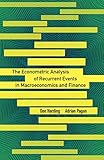The Econometric Analysis of Recurrent Events in Macroeconomics and Finance / Adrian Pagan, Don Harding.
Material type: TextSeries: The Econometric and Tinbergen Institutes LecturesPublisher: Princeton, NJ : Princeton University Press, [2016]Copyright date: ©2016Description: 1 online resource (232 p.) : 20 line illus. 18 tablesContent type:
TextSeries: The Econometric and Tinbergen Institutes LecturesPublisher: Princeton, NJ : Princeton University Press, [2016]Copyright date: ©2016Description: 1 online resource (232 p.) : 20 line illus. 18 tablesContent type: - 9780691167084
- 9781400880935
- Econometric models
- Econometrics
- Economics -- Statistical methods
- Economics; Statistical methods
- Macroeconomics -- Mathematical models
- BUSINESS & ECONOMICS / Econometrics
- Markov switching models
- amplitudes
- binary states
- bivariate series
- business cycles
- contraction
- cycles financial series
- cycles
- dating cycles
- dating
- durations
- economic activity
- economic models
- economic recessions
- economy
- event indicators
- expansion
- financial cycles
- financial shocks
- fluctuation
- global financial crisis
- linear autoregression
- macroeconomy
- microeconometrics
- model-based rules
- multiple series
- oscillation
- peaks
- policymakers
- prediction
- recession
- recurrent events
- recurrent states
- regression
- statistics
- synchronization
- time series
- time
- troughs
- univariate series
- volatility
- 339.015195 23
- HB172.5 .H3 2018
- online - DeGruyter
- Issued also in print.
| Item type | Current library | Call number | URL | Status | Notes | Barcode | |
|---|---|---|---|---|---|---|---|
 eBook
eBook
|
Biblioteca "Angelicum" Pont. Univ. S.Tommaso d'Aquino Nuvola online | online - DeGruyter (Browse shelf(Opens below)) | Online access | Not for loan (Accesso limitato) | Accesso per gli utenti autorizzati / Access for authorized users | (dgr)9781400880935 |
Frontmatter -- Contents -- Series Editors' Introduction -- Preface -- Chapter 1. Overview -- Chapter 2. Methods for Describing Oscillations, Fluctuations, and Cycles in Univariate Series -- Chapter 3. Constructing Reference Cycles with Multivariate Information -- Chapter 4. Model-Based Rules for Describing Recurrent Events -- Chapter 5. Measuring Recurrent Event Features in Univariate Data -- Chapter 6. Measuring Synchronization of Recurrent Events in Multivariate Data -- Chapter 7. Accounting for Observed Cycle Features with a Range of Statistical Models -- Chapter 8. Using the Recurrent Event Binary States to Examine Economic Modeling Issues -- Chapter 9. Predicting Turning Points and Recessions -- References -- Index
restricted access online access with authorization star
http://purl.org/coar/access_right/c_16ec
The global financial crisis highlighted the impact on macroeconomic outcomes of recurrent events like business and financial cycles, highs and lows in volatility, and crashes and recessions. At the most basic level, such recurrent events can be summarized using binary indicators showing if the event will occur or not. These indicators are constructed either directly from data or indirectly through models. Because they are constructed, they have different properties than those arising in microeconometrics, and how one is to use them depends a lot on the method of construction.This book presents the econometric methods necessary for the successful modeling of recurrent events, providing valuable insights for policymakers, empirical researchers, and theorists. It explains why it is inherently difficult to forecast the onset of a recession in a way that provides useful guidance for active stabilization policy, with the consequence that policymakers should place more emphasis on making the economy robust to recessions. The book offers a range of econometric tools and techniques that researchers can use to measure recurrent events, summarize their properties, and evaluate how effectively economic and statistical models capture them. These methods also offer insights for developing models that are consistent with observed financial and real cycles.This book is an essential resource for students, academics, and researchers at central banks and institutions such as the International Monetary Fund.
Issued also in print.
Mode of access: Internet via World Wide Web.
In English.
Description based on online resource; title from PDF title page (publisher's Web site, viewed 30. Aug 2021)


